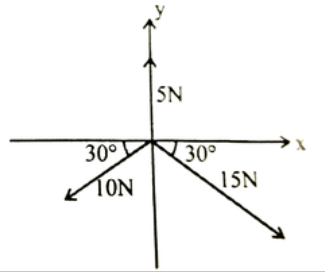Sum of magnitude of two forces is 20 N and magnitude of their resultant is 10 N. If resultant is perpendicular to the smaller force find values of both forces.
5.5 N, 14.5 N
7.5 N, 12.5 N
15 N, 5 N
12 N, 8 N
The correct Answer is:C
To solve the problem, we will denote the two forces as FA and FB. We know the following:
1. The sum of the magnitudes of the two forces is 20 N:
FA+FB=20(1)
2. The magnitude of the resultant force FR is 10 N:
FR=10(2)
3. The resultant FR is perpendicular to the smaller force, which we will assume to be FB.
Using the Pythagorean theorem, since FR is perpendicular to FB, we can write:
F2R=F2A−F2B(3)
Substituting the known value of FR from equation (2) into equation (3):
102=F2A−F2B
100=F2A−F2B(4)
Now, we can express F2A−F2B in terms of FA+FB and FA−FB. We can rewrite equation (4) as:
F2A−F2B=(FA+FB)(FA−FB)
From equation (1), we know FA+FB=20. Let’s denote FA−FB as x:
F2A−F2B=20⋅x(5)
Now we can set equations (4) and (5) equal to each other:
20x=100
x=10020=5(6)
Now we have FA−FB=5 (from equation (6)). We can now solve the system of equations:
1. FA+FB=20 (equation (1))
2. FA−FB=5 (equation (6))
Adding these two equations:
(FA+FB)+(FA−FB)=20+5
2FA=25
FA=252=12.5N(7)
Now substituting FA back into equation (1) to find FB:
12.5+FB=20
FB=20−12.5=7.5N(8)
Thus, the magnitudes of the two forces are:
FA=12.5NandFB=7.5N
Summary of the Solution:
- Magnitude of Force A (FA) = 12.5 N
- Magnitude of Force B (FB) = 7.5 N
FA+FB=20(1)
FR=10(2)
F2R=F2A−F2B(3)
102=F2A−F2B
100=F2A−F2B(4)
F2A−F2B=(FA+FB)(FA−FB)
F2A−F2B=20⋅x(5)
20x=100
x=10020=5(6)
1. FA+FB=20 (equation (1))
2. FA−FB=5 (equation (6))
(FA+FB)+(FA−FB)=20+5
2FA=25
FA=252=12.5N(7)
12.5+FB=20
FB=20−12.5=7.5N(8)
FA=12.5NandFB=7.5N
- Magnitude of Force A (FA) = 12.5 N
- Magnitude of Force B (FB) = 7.5 N
Topper's Solved these Questions
Similar Questions
The sum of magnitudes of two forces acting at a point is 16N. If the resultant force is 8N and its direction is perpendicular to smaller force, then the forces are :-
View SolutionThe sum of the magnitudes of two forces acting at a point is 18 and the magnitude of their resultant is 12. If the resultant is at 90∘ with the force of smaller magnitude, What are the magnitudes of forces?
View SolutionThe sum of the magnitudes of two forces acting at a point is 18 and the magnitude of their resultant is 12. If the resultant is at 90∘ with the force of smaller magnitude, What are the magnitudes of forces?
View SolutionThe sum of the magnitudes of two forces acting at a point is 16 N. The resultant of these forces is perpendicular to the smaller force has a magnitude of 8 N. If the smaller force is magnitude x, then the value of x is (A) 2N (B) 4N (C) 6N (D) 7N
View SolutionTwo forces are such that the sum of their magnitudes is 18N and their resultant is 12 N which is perpendicular to the smaller force. Then the magnitude of the forces are
View SolutionFind the magnitude of the resultant of shown forces :-

View SolutionSum of magnitudes of the two forces acting at a point is 16N if their resultant is normal to the smaller forces and has a magnitude 8N then the forces are .
View SolutionThe sum of two forces at a point is 16N. if their resultant is normal to the smaller force and has a magnitude of 8N, then two forces are
View SolutionThe sum of two forces at a point is 16N. if their resultant is normal to the smaller force and has a magnitude of 8N, then two forces are
View SolutionThe resultant of two forces acting an anlge of 120∘ is 10 kg wt and is perpendicular to one of the forces. That force is
View Solution